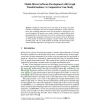Free Online Productivity Tools
i2Speak
i2Symbol
i2OCR
iTex2Img
iWeb2Print
iWeb2Shot
i2Type
iPdf2Split
iPdf2Merge
i2Bopomofo
i2Arabic
i2Style
i2Image
i2PDF
iLatex2Rtf
Sci2ools
AGTIVE
2007
Springer
2007
Springer
Model-Driven Software Development with Graph Transformations: A Comparative Case Study
Abstract. Significant achievements have been made in the design and implementation of languages and tools for graph transformation systems. However, many other competing approaches have been developed for model-driven software development. We present a case study in which we applied different modeling approaches in the construction of a tool for software process management. re these approaches with respect to the respective levels of abstraction on which models are defined, the language concepts offered, and the resulting modeling effort. The case study identifies the benefits and shortcomings of the selected modeling approaches, and suggests areas of future improvement.
| Added | 12 Aug 2010 |
| Updated | 12 Aug 2010 |
| Type | Conference |
| Year | 2007 |
| Where | AGTIVE |
| Authors | Thomas Buchmann, Alexander Dotor, Sabrina Uhrig, Bernhard Westfechtel |
Comments (0)

